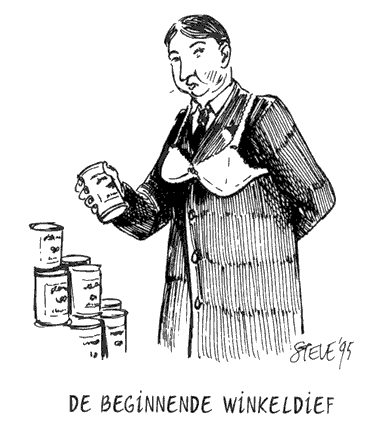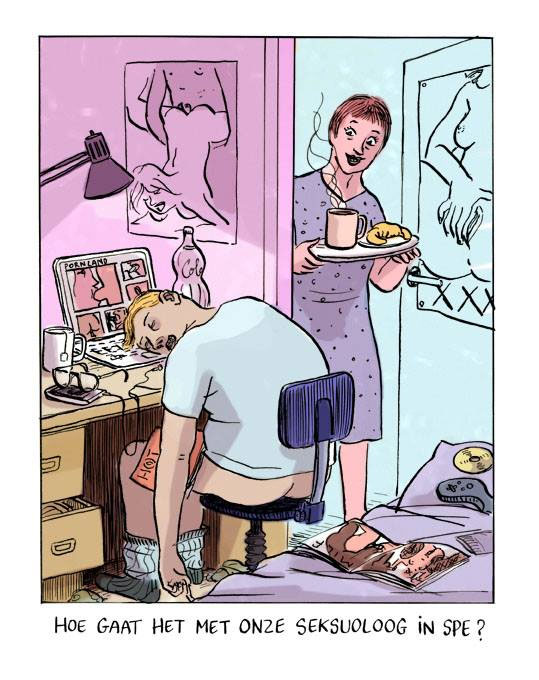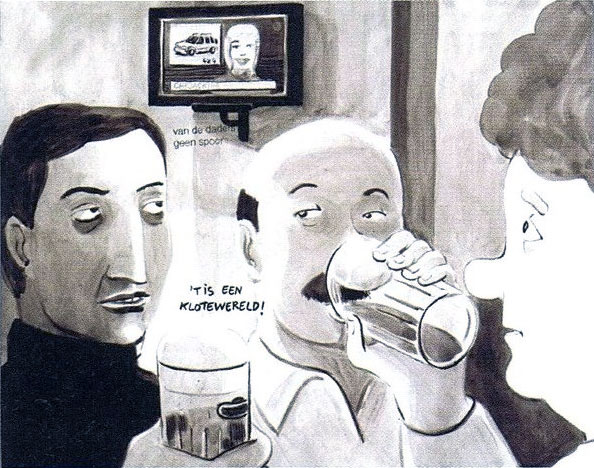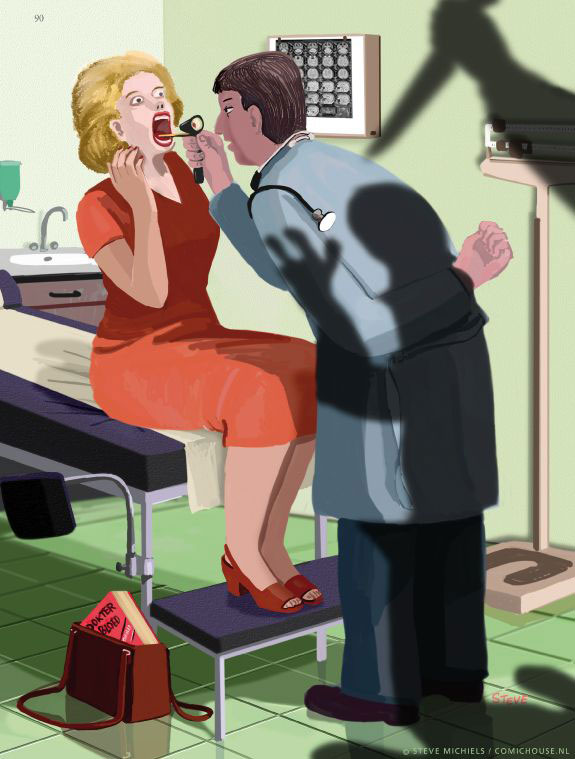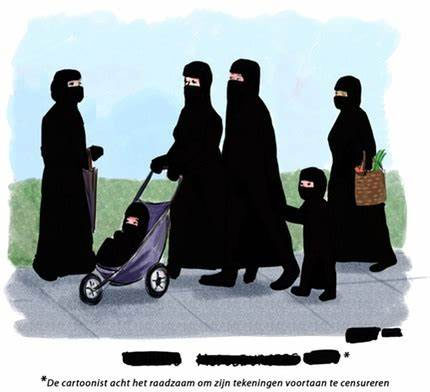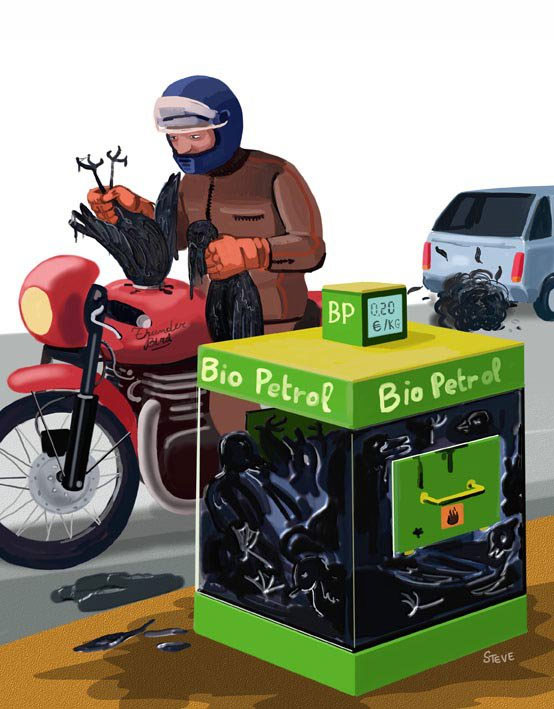Steve Michiels is a Belgian cartoonist, illustrator and animator who publishes under his first name. Many of his cartoons and comics are soft-colored illustrations with an emphasis on visual, surrealist comedy. His characters tend to be everyday civilians in odd and sometimes disturbing situations. Steve also published a graphic novel, 'Burgerlijke Schemering' (2010). A recurring character in his work is Albert, a balding middle-aged man with a black mustache.
Early life and career
Steve René Michiels was born in 1970 in Lokeren, East Flanders, and grew up in the nearby town Zele. He was interested in drawing from a young age. Among his graphic influences are Pirana, Peter van Straaten, Willy Vandersteen, Kamagurka, Benoît, Saul Steinberg, René Magritte, Frans Masereel, Art Spiegelman, Charles Addams, Glen Baxter, Cheri Samba, Gary Larson, Matt Groening and The New Yorker cartoonists. He also expressed admiration for Bart Schoofs. As a teenager, Steve regularly paid a visit to the well-known cartoonist Pirana, who lived in the same town. In 1986, at age 16, Steve became a cartoonist for the Gazet van Zele, a local weekly newspaper. He kept drawing cartoons for this paper for four years.
Cartoon by Steve. "'First-time shoplifter", 1995.
Steve studied graphic art at the Sint-Lukas School of Arts In Brussels and successively at the Royal Academy of Fine Arts in Ghent. His thesis was the picture book 'Ha-A-Ai, Lief en Leed' (Geknipt Papier, 1992), which was also published in a limited edition and distributed to specialized comic stores. One of his idols, Benoît, read his book and wrote him a letter of praise. They started a correspondence, and Van Innis taught the young man a lot about page composition. Another veteran cartoonist, Kamagurka, mentioned Steve in a 1993 interview in De Morgen, calling him a "young, promising talent". Steve also published a small comic book, 'Avonturen van Ridder Schelfhout', on his own account.
Cartoon by Steve. Translation: "How's our prospective sexologist?"
Career
In 1993, thanks to Kamagurka's recommendation, Steve made his professional debut in newspaper De Morgen. He provided illustrations for the weekly 'Ter Zake' column in the Saturday supplement. As the column often dealt with economics, he considered it a challenge to liven up this dry topic. Throughout the decades, his cartoons appeared in Humo, Knack, AGENDA Magazine, Bruzz, TV-Expres, Teek, Bonanza, De Tijd, Het Laatste Nieuws and De Standaard. In the Netherlands, they were published in NRC Handelsblad, VPRO Gids, Het Parool and Vrij Nederland, while French audiences were introduced to his work in the pages of Fluide Glacial. Steve was also one of the earliest Flemish cartoonists to make his cartoons available online. He first posted them on the Internet in 1996, and then established his own website 'All About Steve' (a pun on the film 'All About Eve') in 1999. During his early career, Steve's main source of income was painting decorations for porcelain plates which city/town councils hand out to jubilees. Since 2004, Steve has taught Illustration and Graphics at the Sint-Lukas School of Arts in Ghent. Among his pupils were the cartoonists Brecht Evens and Brecht Vandenbroucke. Steve is a member of the collective and website The Cartoonist, hosted by Marec, where Belgian cartoonists make their archive and latest work available to the public.
'Burgerlijke Schemering'.
Style
Steve gained notability with his soft-colored single-panel cartoons and one-page gag comics. He draws them with aid from a tablet and mousepen, colorizing them with pastel and gouache. Despite the gentle-looking style, the comedy can be quite dark and disturbing. Through his use of absurd situations with unfazed characters, Steve fits within the Belgian surrealist tradition. Yet he differs from most other Belgian cartoonists by being apolitical and using as little text as possible. Steve avoids caricature and references to specific current events. While his cartoons observe changes in society, he picks out general, more timeless topics so his work has long-term relevance. He also prefers visual comedy, since too many words distract from the illustration. His cartoons have been collected in several books, including 'Dagelijkse Pret' (1997), 'Verdoken Liefde' (Van Halewyck, 2000, with a foreword by rock musician Raymond van het Groenewoud), 'Ons Dagelijks Brood (Van Halewyck, 2000), 'Fijn Stof' (Popville Editions, 2007) and 'Stoelen Aan De Kant. Plezier Onderweg, Thuis en Daarbuiten' (Vrijdag, 2016).
Burgerlijke Schemering
In 2010, Steve published his first graphic novel, 'Burgerlijke Schemering' ("Civil Twilight", De Harmonie, 2010). The title refers to the scientific term when daylight transcends into night time. A balding man with a black mustache, Albert, goes out for a drink when the evening falls. He passes by daft and horrifying events until he reaches his favorite tavern. While he is out, his wife organizes a tea party, which also takes a disturbing turn. The story is a metaphor for the twisted things that hide beneath a facade of normalcy, waiting to come out at night. 'Burgerlijke Schemering' features one illustration per page. This cinematic aspect allows for a slower reading tempo where the detailed images can absorb into the audience's mind. Again, little dialogue is used. Originally Steve envisioned his story as a traditional balloon comic, but he didn't like the end result. In the back of the final book, he added this early version as well as preliminary sketches, while explaining his motivations and working method. These extras were intended as a tongue-in-cheek "making of", comparable to extras on a DVD. Interviewed by Geert De Weyer for De Morgen (7 December 2010), Steve explained he was inspired by reality shows, which spend far more attention to "making and preparing" an excellent pop singer, cook or top model than the end result. The book was also translated into French as 'Crépuscule Civil'. The Belgian graphic artist Ever Meulen named 'Burgerlijke Schemering' one of the best books of the year.
A spin-off, 'Het Land van Albert', was serialized in Focus Knack during the 2010s. Contrary to 'Burgerlijke Scherming', this was closer to a traditional balloon comic, ending on a punchline. But the gags remain quite strange.
Cartoon by Steve.
Book illustrations
As an illustrator, Steve made the drawings for the children's book 'Baby Pop en Billy Boef' (Lannoo, 2002), written by actress Pascale Platel. He has also written and illustrated a children's book of his own: 'Bedtijd' (Lannoo, 2006), about a young boy finding creative ways to avoid being scared in the dark.
Animation
Steve Michiels is one of the scriptwriters and designers for Studio Nix, the animation studio founded by cartoonist Nix to produce animated shorts based on his comic strip 'Kinky & Cosy'. Other studio contributors are Fred Felder, Bart Schoofs, Ben De Wever, AKA Benus and Simon Spruyt. For pay channel Canal+, the team produced the animated short 'Sacrée Soirée' (2012) in cooperation with Cargo Films. The surreal film features Steve's character Albert being taken to the hospital to treat his stomach, which behaves rather strangely. In commission of the Flemish public TV channel VRT and the Flemish Community, Studio Nix also made three animated shorts about historical topics to promote tourist walks in Bruges, Ghent and Mechelen.
'Bruss. 2: Brussels In Shorts', 2014.
Graphic and written contributions
Steve wrote a contribution to 'Er Was Geenszins' (Oogachtend, 2007), a collection of absurd fairy tales aimed at an adult audience, written by various authors, all illustrated by Kim Duchateau. He contributed a comic strip about René Magritte to the collection 'Bruss. 2: Brussels In Shorts' (Oogachtend, 2014). In an interesting side note, Steve's own grandparents lived in the Prudent Bolslaan, only a few streets away from Magritte's home in the Esseghemstraat in Jette. Steve was one of many Belgian cartoonists to make special cartoons and comics for Gilles Dal's book 'België, et cetera' (Van Halewyck, 2016), a funny look at the history of Belgium. The same year he was interviewed by Roel Daenen for his book 'Het Is Maar Om Te Lachen: Hoe Cartoonisten De Wereld Veranderen' (Polis, 2016), which collects interviews with Belgian cartoonists regarding censorship, in the light of the 2015 terrorist attacks at the headquarters of the French satirical magazine Charlie-Hebdo. Steve was additionally one of several artists to pay graphic tribute to Ever Meulen during the 'Ever Meulen & Friends' exhibition in Brussels (October 2017).
Controversy
On two occasions, Steve caused controversy with religion-themed cartoons. Many readers of Focus Knack were offended by his cartoon in which a lewd priest offers a different interpretation of Jesus' saying "Let the children come to me" to some scared little children. Similar outrage was sparked by a cartoon of a urinating Maria statue while a woman yells: "It's a miracle!".
"*The cartoonist thinks it's wise to censor his drawings from now on."
Recognition
Steve's book illustrations for 'Baby Pop en Billy Boef' won a 2003 Gouden Pluim ("Golden Plume") award. In 2007, Steve won the BeNe-Prize for "Best Dutch/Belgian Cartoon". The winning drawing commented on the international outrage over cartoons depicting the Prophet Muhammad in the Danish newspaper Jyllands-Posten. He reused an older cartoon depicting a nude family walking on the street and covered their body parts with censor bars. Even the punchline is covered up. This also gave the impression that the characters wore black burqas. In 2015, Steve's work was exhibited in Aix-en-Provence, France, under the title 'Pourquoi On Ne Rit Pas Avec Steve Michiels?'. Between 15 January and February 2018, his work was exhibited in Sublim in the Kerkstraat in Lokeren.
Cartoon for De Standaard (12 June 2010).




